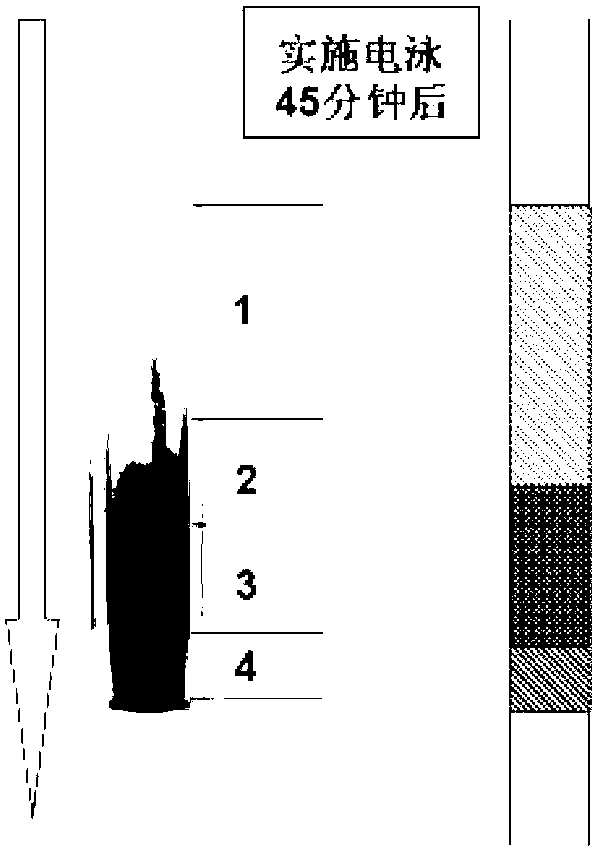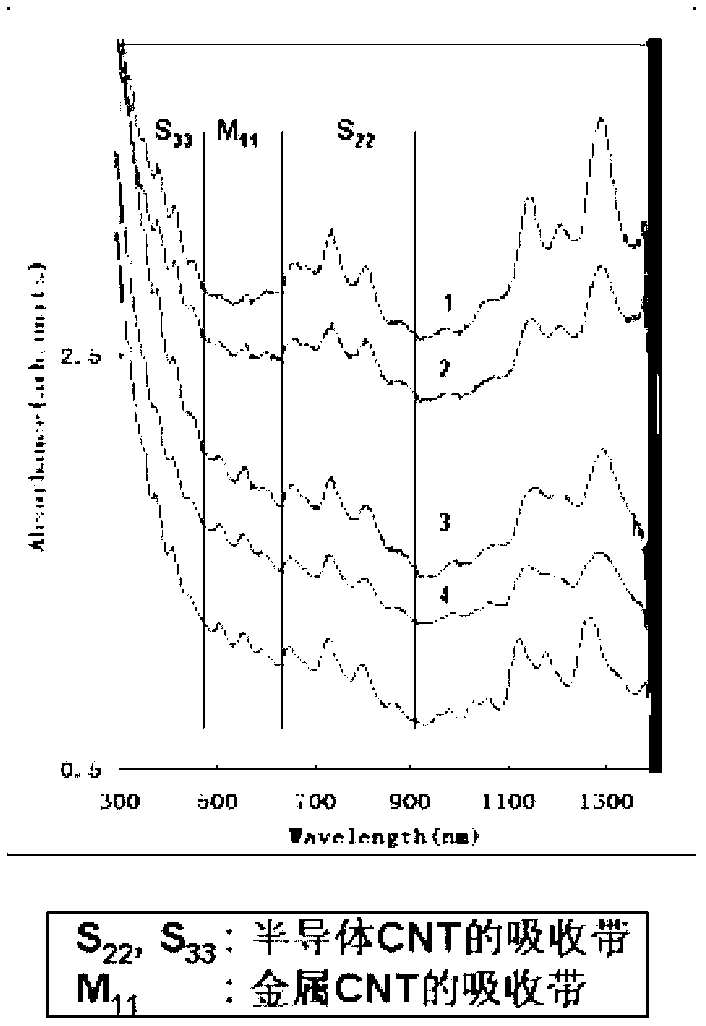Method for separating metal or semiconductive carbon nanotubes
A carbon nanotube, separation method technology, applied in nanotechnology, nanotechnology, nanostructure fabrication, etc.
- Summary
- Abstract
- Description
- Claims
- Application Information
AI Technical Summary
Problems solved by technology
Method used
Image
Examples
Embodiment 1
[0075] [Preparation of CNT dispersion]
[0076] Weigh 1.2mg of HiPco-CNT (Lot number P0276, Carbon Nanotechnologies.Inc.TX, diameter 1.0±0.3nm) sample, add 3.2ml of 1.2%SDS-0.8%SC mixed aqueous solution. Put the above solution in a circulating tap water bath, use a drill-type ultrasonic breaker (Misonix XL2000) to continuously sonicate for 2 hours (level 6), centrifuge for 4 hours, and take the supernatant. This solution contains many isolated and monodisperse CNTs. Sucrose (50% aqueous solution) at a final concentration of 10% was added to the supernatant to prepare a sample for electrophoresis.
[0077] [Gel electrophoresis]
[0078] Gel for electrophoresis (1 / 10 of the amount of surfactant at the time of ultrasonic dispersion added to 0.4% low-melting point agarose, in this case 0.12% SDS and 0.08% SC; and TB buffer) was prepared in In a quartz tube with a length of 10 cm, an outer diameter of 7 cm, and an inner diameter of 6 cm. Use TB buffer solution containing 1 / 10 o...
Embodiment 2
[0084] The difference from Example 1 is:
[0085] The carbon nanotubes were replaced by CoMoCAT-CNT (SouthWest NanoTechnologies Inc) HiPco-CNT, and the surfactant was a mixture of 1.2% SDS-0.8% SC replaced by 2% SDS. The electrophoresis buffer used TAE instead of TB, and no surfactant was added. Figure 2a and Figure 2b It shows the gel status photos, schematic diagrams and absorption spectrum test results after 60 minutes of electrophoresis. Compared with the absorption spectrum of the CNT dispersion before electrophoretic separation, it was visually confirmed that the ratio of semiconducting CNTs increased in the light green part (1), and in the light gray part (4) before electrophoresis, An increase in the ratio of metallic CNTs occurred. The ratio of semiconducting and metallic CNTs located in the middle position was almost unchanged from that of the sample before separation. These results indicate that metallic and semiconducting CNTs can be separated using CoMoCAT-C...
Embodiment 3
[0088] The difference from Example 1 is:
[0089] After heating and dissolving 0.8% agarose gel added with ×2TB buffer solution, it was mixed with a 1:1 equal volume HiPco-CNT dispersion in a molten state and stirred at room temperature to make a carbon nanotube package. as a sample for electrophoresis. The surfactant was 2% SDS instead of the mixture of 1.2% SDS-0.8% SC, and the electrophoresis time was 25 minutes. Figure 3a and Figure 3b Indicates the photo of the gel condition at the end of electrophoresis, its model diagram and the test results of absorption spectrum. Different from the results of Example 1, the green (1) semiconducting CNT located in the carbon nanotube package that does not move with electrophoretic movement but is still is separated and swims out of the carbon nanotube package. , a metallic CNT in light brownish red (2) located at the front of electrophoresis. On the other hand, there are almost no carbon nanotubes in the intermediate position. T...
PUM
 Login to View More
Login to View More Abstract
Description
Claims
Application Information
 Login to View More
Login to View More - R&D
- Intellectual Property
- Life Sciences
- Materials
- Tech Scout
- Unparalleled Data Quality
- Higher Quality Content
- 60% Fewer Hallucinations
Browse by: Latest US Patents, China's latest patents, Technical Efficacy Thesaurus, Application Domain, Technology Topic, Popular Technical Reports.
© 2025 PatSnap. All rights reserved.Legal|Privacy policy|Modern Slavery Act Transparency Statement|Sitemap|About US| Contact US: help@patsnap.com



